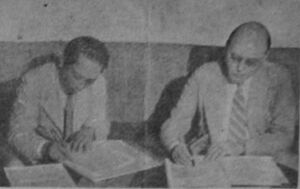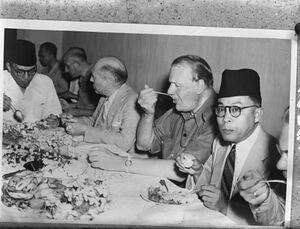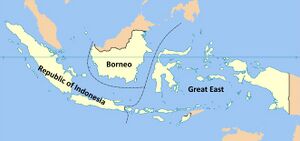اتفاقية لينغاجاتي
A newsreel about the ratification of the Linggardjati Agreement on 15 November 1946 by Indonesian and Dutch representatives. | |
| النوع | political accord |
|---|---|
| وُقـِّعت | 15 نوفمبر 1946 |
| المكان | Linggadjati, Kuningan Regency |
| الأطراف | |
| هذا المقال هو جزء من سلسلة تاريخ إندونيسيا |
|---|

|
| انظر أيضاً: |
| قبل التاريخ |
| الممالك المبكرة |
| سري ڤيجايا (القرون الثالث إلى الرابع عشر) |
| تاروما نگارا (358-723) |
| سايلندرا (القرنان الثامن والتاسع) |
| مملكة سوندا (669-1579) |
| مملكة مطرم (752–1045) |
| كديري (1045–1221) |
| سنغاساري (1222–1292) |
| ماجاپاهيت (1293–1500) |
| نشأة الدول الإسلامية |
| انتشار الإسلام (1200–1600) |
| سلطنة ملقا (1400–1511) |
| سلطنة دماك (1475–1518) |
| سلطنة آچه (1496–1903) |
| سلطنة بانتن (1526–1813) |
| سلطنة مطرم (1500s to 1700s) |
| الاستعمار الاوروبي |
| البرتغاليون (1512–1850) |
| شركة الهند الشرقية الهولندية (1602–1800) |
| الهند الشرقية الهولندية (1800–1942) |
| بزوغ إندونيسيا |
| الصحوة الوطنية (1899–1942) |
| الاحتلال الياباني (1942–45) |
| إعلان الإستقلال (1945) |
| الثورة الوطنية (1945–1950) |
| إندونيسيا المستقلة |
| الديمقراطية الليبرالية (1950–1957) |
| الديمقراطية المهدية (1957–1965) |
| بداية النظام الجديد (1965–1966) |
| النظام الجديد (1966–1998) |
| عصر الإصلاح (1998–الحاضر) |
| عدّل هذا القالب |
اتفاقية لينگاجاتي ( Linggardjati Agreement ؛ Linggarjati in modern Indonesian spelling)[ب] was a political accord concluded on 15 November 1946 by the Dutch administration and the unilaterally declared Republic of Indonesia in the village of Linggarjati, Kuningan Regency, near Cirebon in which the Dutch recognised the republic as exercising de facto authority في جاوة و مادورا و سومطرة.
. . . . . . . . . . . . . . . . . . . . . . . . . . . . . . . . . . . . . . . . . . . . . . . . . . . . . . . . . . . . . . . . . . . . . . . . . . . . . . . . . . . . . . . . . . . . . . . . . . . . . . . . . . . . . . . . . . . . . . . . . . . . . . . . . . . . . . . . . . . . . . . . . . . . . . . . . . . . . . . . . . . . . . . .
الخلفية
In 1942, the Japanese occupied the Dutch East Indies. On 17 August 1945, two days after the Japanese surrender, Indonesian nationalist leader Sukarno declared Indonesian independence. The Dutch viewed the Indonesian leadership as collaborators with the occupying Japanese, and were determined to reassert their control over the nation by force.[1] Fighting broke out, which developed into a full-scale war of independence between Dutch forces and Indonesian republicans. By mid-1946, both sides were under pressure to negotiate. In July, 1946, Acting Governor-General of the Dutch East Indies Hubertus van Mook organised a conference in Malino at which representatives from Borneo and eastern Indonesia backed the proposal for a federal United States of Indonesia with links to the Netherlands.[2]
المفاوضات

On 3 July 1946 a new Dutch government (Cabinet- Beel) was formed, and this government established a Commission-General to set up a new political structure for the Dutch East Indies. This four-member commission, headed by former Dutch Prime Minister Willem Schermerhorn traveled to Jakarta to negotiate with the republican delegation arrived in Indonesia on 14 September. These negotiations with the Indonesian authorities began on 7 October 1946 and a ceasefire in Java and Sumatra was agreed to and signed on 14 October. Recognizing their still weakened position following World War II, the Netherlands were more prepared to negotiate with the republic than they were later in the Indonesian National Revolution. In November, the negotiations then moved to Cirebon from where it was easier to communicate with Sukarno and Hatta.
Most of the negotiations took place at the residence of the Kwee family of Ciledug, now a museum, in the hill station of Linggadjati around 25 km south of Cirebon, although the final document was actually initialed in Cirebon.[3][4][5][6] The Dutch side comprised the following:
- Willem Schermerhorn, Dutch Prime Minister from 1945-1946
- F. De Boer, Liberal politician
- Max van Poll, Catholic Party politician
- Hubertus van Mook, Lieutenant General Governor (ex officio)
On the Republican side were:
- Sutan Sjahrir, Prime Minister
- أمير شريف الدين, Defense Minister
- Johannes Leimena, Junior Minister of Health, chairman of the Indonesian Christian Party
Former British ambassador to Egypt Lord Killearn acted as intermediary in the early stages, but he was not needed as the two sides established good relations.[7] The two sides initialed the draft agreement on 15 November.[8]
الاتفاقية
The agreement comprised an introduction, 17 articles and a final clause. According to the terms, the Netherlands agreed to recognize the Republic as exercising de facto authority over Java, Sumatra and Madura (Article 1). The Republic would become one of three constituent states of the federal United States of Indonesia, along with the State of Borneo and the Great Eastern State, comprising the region of the Eastern Dutch East Indies known as the Great East. Any region that did not want to join the USI could determine its relationship with the USI and the Netherlands through a democratic process. (Articles 2, 3 & 4). The constitution of the USI would be drawn up by an elected Constituent Assembly. The Netherlands Indies, together with the Netherlands, Suriname, and the Netherlands Antilles, would form a Netherlands-Indonesian Union with the Dutch monarch as official head of this Union (Articles 5, 7 & 8). Both the United States of Indonesia and the Union which would be established by 1 January 1949 at the latest (Article 12). Once the agreement was signed, both parties would reduce their armed forces (Article 16). Any disputes regarding the agreement would be resolved by arbitration in the event that joint consultation failed. The last resort was to be a ruling by the president of the International Court of Justice.[9][10][11][12]
Both sides made concessions. The republicans committed to the establishment of a federal Indonesian state, while the Dutch conceded the inclusion of Sumatra in the Republic of Indonesia as well as Java. The two sides reached a compromise on the form of the relationship between the USI and the Netherlands. The Dutch had wanted a political union (هولندية: staatsverband), while the republicans had wanted merely an alliance (هولندية: bondgenootschap). The final agreement was for the USI to be a "sovereign and equal partner in a union", although the Dutch succeeded in persuading the republicans to agree to the Dutch monarch being the head of this union.[13]
التصديق والتوقيع
The Dutch Commission-General subsequently issued an "Elucidation" to the agreement, interpreting it as a "program of principles" to bring the status of the Dutch kingdom into line with the political facts in the Dutch East Indies. On 10 December 1946, the Dutch government announced its own interpretation of the agreement in a statement from Foreign Minister Jan Jonkman. As a result of pressure from the Dutch Catholic Party, which wanted to conduct missionary activities in the West Papua, Jonkman stated that the region would not after all be handed over to the United States of Indonesia, a statement at odds with article 3 of the Linggadjati Agreement. On 19 December, the Dutch parliament ratified the agreement on the basis of the Commission General's Elucidation.[14][15]
Although the agreement called for the Dutch and the Republican sides to cooperate in the establishment of a federal system, van Mook began to do so unilaterally, and in December, organised the Denpasar Conference which resulted in the establishment of the State of East Indonesia. This increased Republican opposition to the agreement, especially from the Indonesian National Party, Masjumi and followers of Tan Malaka. This led to the establishment of an opposition group, the Republican Fortress (إندونيسية: Benteng Republik). Supporters of Prime Minister Sjahrir and the agreement, including the Socialist Party of Indonesia and the Communist Party of Indonesia formed the Left Wing (إندونيسية: Sayap Kiri). In order to ensure ratification of the agreement, the Central Indonesian National Committee was increased in size through the appointment of government supporters and this, together with resignation threats from Indonesia leaders Sukarno and Hatta, ensured the agreement was ratified by the Indonesian side on 5 March 1947.[16]
The agreement was signed in Jakarta at 5.30pm on 25 March 1947 in the presence of 70 guests from the Netherlands, Indonesia and other nations. The signing was followed by speeches from Schemerhorn, van Mook and Sjahrir. There were celebrations on the streets of Jakarta and Palembang, South Sumatra. However, the agreement had been interpreted differently by the two sides, particularly regarding the meaning of the terms "cooperation" and "federal".[16][17][18]
التطورات اللاحقة
Both sides were unhappy with the agreement, and one member and two advisers to the Commission-General resigned in protest after it was signed. The Dutch were unhappy with the Republic establishing foreign relations, including with the Arab League, and with the Indonesia maintaining governors in the area that had become the State of East Indonesia. Meanwhile, the Indonesians complained about Dutch establishment of states in East Indonesia and West Borneo.[19][20] The Dutch public's reception of the agreement was mixed - a survey found 38% of respondents supporting the agreement and 36% opposing it. One telegram to members of the Dutch Parliament compared the Linggadjati agreement with the Dutch capitulation to Germany in 1940, questioning why the agreement "extradited seventy million Indonesians to Sukarno".[21]
On 27 May 1947, the Commission General proposed the establishment of a federal council headed by a representative of the Dutch crown to serve as an interim government, as well as a joint police force and the regulation of food distribution. The Republic would not be allowed to have an independent foreign policy. The Dutch would cooperate with "various political entities of Indonesia" rather than exclusively the Republic. The Dutch side asked for a response in 14 days. The Indonesian side viewed this as an ultimatum - capitulate to the Dutch or face military action as it would mean de jure Dutch sovereignty over Indonesia. Sjahrir agreed to an interim government, but with the Republic comprising half the membership and East Indonesia and Borneo the other half, with no Dutch participation. He also rejected a combined police force. The Dutch rejected these counter-proposals, but the concessions that Sjahrir had made cost him political support, leaving him fatally weakened. He resigned on 27 June. Sukarno then declared a state of emergency and took personal charge of the negotiations.[22][23]
On 29 June, van Mook wrote to Sukarno to repeat the main points that he believed must be agreed on, including continuing Dutch sovereignty and the joint police force. New Prime Minister Amir Sjariffuddin accepted the de jure Dutch authority, but refused to agree to the joint police force. The Dutch then also demanded an end to Republican hostilities, and the food blockade of Dutch-controlled areas by midnight on 16 July. The Republicans agreed to a ceasefire if the Dutch would also be bound by it. The Indonesian side also suggested arbitration under Article 17 of the agreement. However, on 20 July the Dutch abrogated the Linggadjati Agreement and following a recommendation by van Mook, Dutch Prime Minister Louis Beel ordered the army to commence military intervention. This began on the night of 20–21 July in form of Operation Product.[24][25]
انظر أيضاُ
- Timeline of the Indonesian National Revolution
- Nationaal Comité Handhaving Rijkseenheid
- Dutch police actions
- Renville Agreement
ملاحظات
- ^ Ricklefs 2008, p. 341-344.
- ^ Ricklefs 2008, pp. 358-360.
- ^ Wehl 1948, p. 145.
- ^ Post, Peter (2019). The Kwee Family of Ciledug: Family, Status, and Modernity in Colonial Java (in الإنجليزية). Volendam: LM Publishers. ISBN 9789460224928. Retrieved 11 November 2019.
- ^ Taylor 1960, pp. 28-29.
- ^ William & Robert 1993.
- ^ Fischer 1959, p. 95.
- ^ Fischer 1959, p. 96.
- ^ Ricklefs 2008, p. 361.
- ^ Wehl 1948, p. 146-148.
- ^ Kahin 1952, p. 196.
- ^ Taylor 1960, p. 29.
- ^ Taylor 1960, p. 30.
- ^ Agung 1995, p. 95.
- ^ Taylor 1960, pp. 30-31.
- ^ أ ب Kahin 1952, pp. 199-206.
- ^ Wehl 1948, pp. 159-161.
- ^ Taylor 1960, p. 31.
- ^ Wehl 1948, p. 59.
- ^ Taylor 1960, p. 33.
- ^ Burgers 2010, pp. 509-510.
- ^ Taylor 1960, pp. 35-36.
- ^ Kahin 1952, pp. 206-208.
- ^ Taylor 1960, pp. 37-38.
- ^ Kahin 1952, pp. 211-212.
المراجع
- Burgers, Herman (2010). "Het conflict tussen Nederland en de Republiek Indonesië". De garoeda en de ooievaar: Indonesië van kolonie tot nationale staat (in الهولندية). BRILL. pp. 503–620. JSTOR 10.1163/j.ctt1w76wq4.14.
- Fischer, Louis (1959). The Story of Indonesia (4th ed.). New York: Harper & Brothers.
- Frederick, William H.; Worden, Robert L., eds. (1993), The National Revolution, 1945-50, Washington, D.C.: Library of Congress, http://countrystudies.us/indonesia/16.htm, retrieved on 1 December 2009.
- Kahin, George McTurnan (1952). Nationalism and Revolution in Indonesia. Ithaca, New York: Cornell University Press.
- Ricklefs, M. C. (2008) [1981]. A History of Modern Indonesia Since c. 1300 (4th ed.). London: Palgrave Macmillan. ISBN 978-0-230-54685-1.
- Taylor, Alastair M. (1960). Indonesian Independence and the United Nations. London: Stevens & Sons.
- Wehl, David (1948). The Birth of Indonesia. London: George Allen & Unwin Ltd.
. . . . . . . . . . . . . . . . . . . . . . . . . . . . . . . . . . . . . . . . . . . . . . . . . . . . . . . . . . . . . . . . . . . . . . . . . . . . . . . . . . . . . . . . . . . . . . . . . . . . . . . . . . . . . . . . . . . . . . . . . . . . . . . . . . . . . . . . . . . . . . . . . . . . . . . . . . . . . . . . . . . . . . . .
وصلات خارجية
- Short description matches Wikidata
- Articles containing هولندية-language text
- Pages using Lang-xx templates
- Articles containing إندونيسية-language text
- Articles with hatnote templates targeting a nonexistent page
- CS1 الهولندية-language sources (nl)
- Indonesian National Revolution
- Treaties concluded in 1946
- معاهدات إندونيسيا
- معاهدات هولندا
- تاريخ جاوة
- 1946 في جزر الهند الشرقية الهولندية
- 1946 في إندونيسيا
- العلاقات الإندونيسية الهولندية
- الولايات المتحدة الإندونيسية
- أحداث نوفمبر 1946 في آسيا
- وثائق 1946


